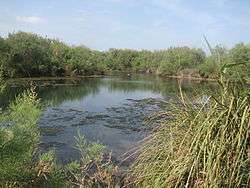Nahal Taninim

Nahal Taninim (Hebrew: נחל תנינים, lit. Crocodile Stream) is a river in Israel, originating near Ramot Menashe and emptying into the Mediterranean Sea south of Ma'agan Michael. The Arabic name of the river is Wadi a-Zarka.
The river is named for the crocodiles that inhabited the nearby Kebara swamps until the early 20th century. The remains of Crocodilopolis, a city established there in the fourth century BCE, are still visible today.[1]
The area of the basin and its tributaries is about 200 square kilometers, including the Taninim, Ada, Barkan, Alona and Mishmarot streams. Nahal Taninim is the cleanest of Israel’s coastal rivers.[2] Three waterways meet in Nahal Taninim: the natural stream, a Roman aqueduct extending from the Zabrin springs to Caesarea, and Mifale Menashe, the waterworks that collect surface runoff water and springwater, routing it into the subterranean water table.[3]
The dense undergrowth and reeds along Nahal Taninim are home to many different birds, among them waterside warblers and other songbirds.[4]
According to a Tel Aviv University zoologist, Nile crocodiles and hippopotami were seen by pilgrims who visited the area three centuries ago.[5] The last recorded sighting of a crocodile was in 1912.[6]
See also
- Geography of Israel
- Wildlife of Israel
- Tourism in Israel
- National parks and nature reserves of Israel
References
- ↑ One of the last clean rivers in Israel, Jerusalem Post
- ↑ One of the last clean rivers in Israel, Jerusalem Post
- ↑ Nahal Taninim Master plan
- ↑ Birding along the Mediterranean
- ↑ Israeli vacationers tiptoeing on beach after reports of crocodile in Sea of Galilee
- ↑ One of the last clean rivers in Israel, Jerusalem Post
Coordinates: 32°32′51″N 34°54′54″E / 32.54750°N 34.91500°E
| Wikimedia Commons has media related to Taninim Stream. |